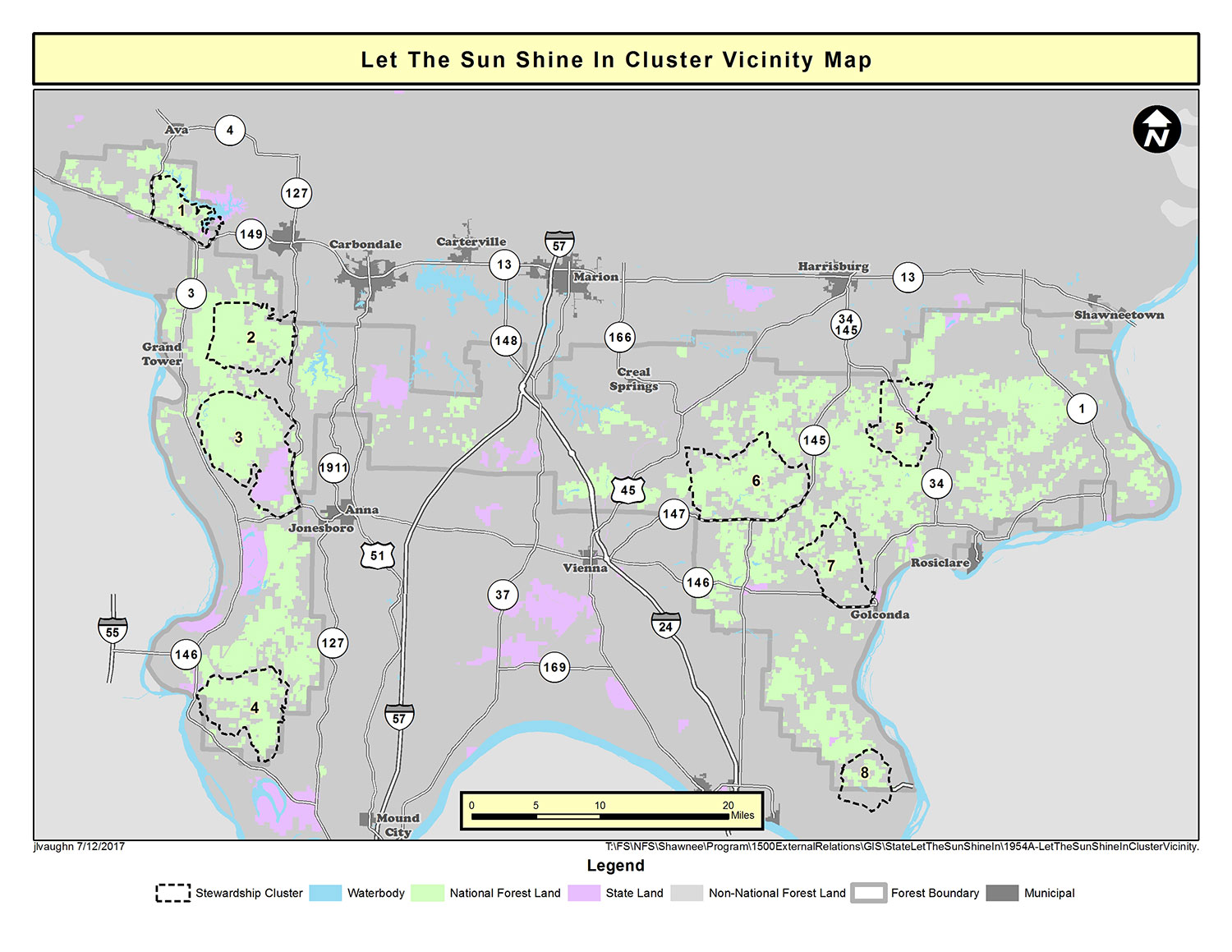What does a healthy oak-dominated forest look like?
Walk into a southern Illinois forest, today, even in the middle of a sunny day, and you might feel like you’re in a dungeon. That’s because in many oak forests less than 5% of available sunlight is reaching the forest floor. That is not a healthy forest! In fact, many landowners and nature-lovers have never really seen a healthy oak forest in southern Illinois.
A healthy oak forest has an open canopy, with sunlight penetrating and illuminating a diverse understory. There would be predominantly oak and hickory saplings at eye-level and higher in the mid-story. And the forest floor would be alive with oak seedlings and non-woody flowering plants. A variety of birds and bees and butterflies are common on or near the forest floor in a healthy forest. Of course, there would be no non-native invasive species present.
In southwestern Illinois, a healthy oak forest in what’s known as the Illinois Ozarks (including parts of Jackson, Union, and Alexander counties), would have 30-50% of available sunlight reaching the understory and forest floor. In the drier Shawnee Hills (including parts of Pope, Hardin, and Saline counties), a healthy oak forest could be even more open and have a parklike appearance.

What is the history of oak-dominated forests in southern Illinois?
Oak dominated forests have been in southern Illinois since just after the last ice age. During all that time, they persisted because, unlike many other tree species, they can survive most forest fires. Thus, natural fires and those set or caused by native Americans helped maintain oak forests in southern Illinois for millennia.
Fast forward several thousand years and surveyors’ notes from the early 1800s tell us what these forests looked like 200 years ago. Witness trees chosen by those surveyors to mark land corners were predominantly big oaks. There were other tree species present, especially along creeks, however, oaks were dominant.
What is the value of oak-dominated forests?
Because oak forests have been the dominant forest-type in southern Illinois for thousands of years, the plants and animals of the region have developed a dependence on the resource. The high water-quality and numerous clear creeks in the region are also that way because of the forests. Finally, the oak forests of southern Illinois are a hunter’s paradise.
Biodiversity
The oak-dominated forests of southern Illinois are home to and habitat for thousands of plant and animal species. According to the Illustrated Flora of Illinois, there are approximately 2,400 plant species in southern Illinois. And the LaRue Pine Hills area, just a few miles south of Murphysboro, has a plant species diversity exceeding that of the Great Smokey Mountains National Park!
Forests also provide habitat for most of the wildlife in southern Illinois. Many vulnerable and declining songbird, reptile and amphibian, and pollinator species rely exclusively on forest habitat. Other species such as deer, bobcat, fox, turkey, and others depend on oak forests for an important portion of their habitat needs.
Ecosystem services
Forests often play an underappreciated role in maintaining local air, soil, and water quality. Forested hillsides and wooded riparian areas along waterways reduce erosion and stabilize soil along stream banks, resulting in less non-point source pollution per acre than any other land cover. Trees and plants also take up nutrients that would otherwise flow into waterways causing algal blooms. And of course, forests act as nature’s lungs – pulling carbon dioxide out of the air and releasing oxygen.
Huntable Wildlife
Southern Illinois is a hunter’s paradise. Healthy forests provide prime habitat for many popular game species in southern Illinois including squirrels, wild turkeys, and white-tailed deer.
What are the threats to oak-dominated forests in southern Illinois?
Researchers at Southern Illinois University (SIU) have documented an alarming loss of oaks in our forests. They blame these oak declines on, among other things, a lack of sunlight reaching the forest floor; which is also negatively impacting forest diversity.
Today, oak saplings make up just 1% of young trees in some forests while many of the acorn-producing mature oaks are reaching the end of their lifespans. This situation poses a threat to the whole oak forest ecosystem that includes wildflowers, birds, and other wildlife.
A lack of fire
Slow growing oaks are relatively resistant to fire – much more so than beech and maple trees – because a variety of traits that make them resistant to damage and killing by fire. While relatively frequent forest fire was the norm in southern Illinois for several thousand years, fire has been actively kept off the landscape since the 1930s. In the absence of fire, fast-growing beech and maples shade out the under-story and prevent young oak trees from regenerating.
Invasive Species
Non-native, invasive plant species are a relatively new threat to forest health. Species like bush honeysuckle and autumn olive can move into forests and further complicate the process of oak regeneration by adding to the shade problem in the under-story.
A Vision for the Future
Oak-dominated forests cover hundreds of thousands of acres in; Missouri, Arkansas, Illinois, Ohio, Tennessee, and Kentucky, making-up an area known as the ‘central hardwoods’. These oak forests support many other species directly or indirectly – from deer and turkeys to migrating songbirds, to wildflowers and pollinators. As such, a loss of oaks would be bad news for the species that depend on them.
The Let the Sun Shine In program is making great conservation strides in Illinois and is poised to do big things. As these successes continue to mount, we look forward to exporting this cutting-edge approach to neighboring states with oak forests and similar problems. And that could add up to letting a lot of sun shine into oak forests and making a BIG Difference!!
FOREST MANAGEMENT
Maintaining healthy oak forests in southern Illinois involves using a variety of management techniques. Learn more about proven methods to protect and conserve our forests!
Help us to preserve the forests of Southern Illinois!
LET THE SUN SHINE IN
BECAUSE WITH SUN SHINE COMES LIFE.








